A logical first step in the study of integrated farming activities is the collection of data on systems that are in commercial operation. There is a wide range of integrated farming systems involving aquaculture in Asia in general, and China in particular.
A classification of aquaculture systems involving crops and livestock should be established. Information should be collected on the kinds and extent of integration, inputs and outputs, capital and operating expenses, and profitability of each system. The ultimate aim, to optimize such complex integrated farming systems, will require protracted study. However, the analysis of existing systems and discussions with farmers concerning current management strategies and problems should enable a large body of relevant data to be amassed in a relatively short period of time. The information may be used to establish hypotheses concerning the functioning of such systems, which may then be tested by experimentation and the establishment of model farms.
The collection of data on integrated fish farming operations is difficult since most farmers keep neither detailed records of inputs into the system nor yields of fish, livestock products and crops. China is an exception to some extent since the farms are organized into collectives; detailed records are generally kept because of the need to determine the amount of profit at the end of each year, which determines how much benefit each farm worker will receive. Furthermore, through keeping detailed records which permit the integrated farming system to be well managed, successive years operations can be gradually improved with a continuous increase in the profitability of the system.
The following ten integrated fish farms were visited during the Consultancy, farms 1–7 in the lower Yangtze River basin and farms 8–10 in the lower Pearl River basin, the two most important fish farming areas in China:
Holei People's Commune Fish Farm, Wuxi Outer District, Jiangsu Province
Wuxi Fish Farm, Li Yuan People's Commune, Wuxi Outer District, Jiangsu Province.
Fishery Team Number 1, Holei People's Commune, Wuxi Outer District, Jiangsu Province
Wang Chuan People's Commune Fish Farm, Wuxi Outer District, Jiangsu Province
Xinan Fish Farm, Li Yuan People's Commune, Wuxi Outer District, Jiangsu Province
Zhang Zhuang Production Brigade, Huang Qiao People's Commune, Wu Xian Country, Jiangsu Province
Jinwen Production Brigade, Tung Shan People's Commune, Wu Xian County, Jiangsu Province
Hongjian Fry and Fingerling Farm, Dangxia People's Commune, Xinhui County, Guangdong Province
Binbu Production Brigade, Shajiao People's Commune, Shunde County, Guangdong Province
. Xinfu Production Brigade, Le Liu People's Commune, Shunde County, Guangdong Province
A flow diagramme has been produced for each of the farms visited, which indicates the interactions or links on the farm. The dashed line represents the boundary of the farm so that the degree of integration of activities within the farm and the inputs from off the farm can be identified. Heavy lines represent major interactions in terms of overall importance to the farm. As mentioned in “Outline Research Programmes for the Regional Aquaculture Lead Centres in Asia - Part III”, there are three major aspects: (i) Crops as fish food; (ii) Livestock manure as pond fertilizer; (iii) Pond mud as crop fertilizer. Clearly however, modern Chinese integrated farms are complex. Farms in the lower Yangtze River basin have major inputs from outside the integrated farm namely, aquatic macrophytes and snails from Lake Taihu. These inputs, together with the larger number of livestock are responsible for the greater fish yields recorded in this area than in the lower Pearl River basin. Those farms observed in the latter area are more fully integrated since a greater proportion of fish pond inputs are produced on the farm.
A description of each farm visited is presented below.
1. Holei People's Commune Fish Farm
The fish farm with a pond area of 1,155 mu (77 ha), was set up in 1976. It is at the Commune level and has a total of 317 able bodied staff. There are two fish production units with 75 people in each, and in addition 14 people raise pigs, 48 raise ducks, and 20 raise cows. In sideline activities on the farm, 12 people are employed in a duck egg processing factory, and 50 in a polyester factory, small parts factory (radio condensers), and a silk worm cocoon processing factory. Sixteen people are involved in general services for the factories and 7 for management and administration. Fish farming is the main emphasis, with sideline activities to serve fish farming in terms of either pond inputs or money to purchase feed and fertilizer.
The fish stocking ratio is typical for the Wuxi area but no data were obtained on fish stocking weight or yield. The fry of the major Chinese carps are purchased but common carp, crucian carp, wuchang fish, and Tilapia mossambica are bred on the farm (Fig. 1). The major feed inputs, aquatic macrophytes and snails are collected off the farm in Taihu Lake. Seven snail sucking machines are used, and in 1980 collected 455 tons of snails. Another major feed input is green fodder, which is mainly purchased since the dike area is small. Agricultural by-products and grain, and pellets, the latter in an experimental way, are added when other sources of feed are inadequate.
The major pond fertilizers are nightsoil and pig manure, the latter mainly from pigs reared on the farm. Since there are 1,050 pigs, there is an equivalent of 13.6 pigs/ha. The liquid waste and washings from two cow sheds housing 100 cows are collected in a sump from which they are pumped and distributed to the fish ponds by pipes and open channels. Solid cow waste is used as a crop fertilizer or as pond basal manure in winter. There are also nine ducksheds, with a total of 2,200 ducks. Most of the ducks are enclosed at a distance from the ponds, and the wastewater is distributed in a similar way to the liquid cow waste. Pigs and cows are bred on the farm but ducklings are purchased. Pigs and ducks are fed substantial amounts of cultivated water hyacinth and cows land fodder, supplemented with agricultural by-products and grain. The water hyacinth is cultivated in a canal adjacent to the farm. Silk worm pupae waste water is also a significant fish pond fertilizer.
The crops grown on the fish pond dikes: rye grass, sudan grass, soy bean etc., are cultivated mainly for fish feed. Since the fish ponds are relatively new, pond mud has not yet been used as a crop fertilizer. Nightsoil and solid cow manure are used also to fertilize crops. The seeds are produced on the farm.
There are two sideline activities that are directly connected with fish farming. Duck eggs are processed and marketed as preserved eggs. Poor quality silk worm cocoons are processed to remove the silk fibres, which are dried and sent to a furniture factory for use as stuffing material. The pupae are partially dried by centrifugation and then sun dried before export as ingredients for medicine. In rainy weather, when the pupae cannot be sun dried, they are used as fish feed.
2. Wuxi Fish Farm
A state run fish farm set up in 1958, which consists of three Production Teams raising fish, a small plastics factory, and a wooden boat building yard. There are 110 staff members, 40 of whom are involved in fish farming; the rest either raise pigs and vegetables or work in sideline occupations.
The main function of the farm with a pond area of 184 mu (12.3 ha), is to supply the various fish farms in the Wuxi area with fry and fingerlings of Chinese carps. Team 1 maintains brood stock, breeds the fish and produces fry; team 2 is a nursery operation producing two sizes of fingerlings; and team 3 produces table size fish. The total fry output in 1981 was about 20 million, and in 1982 the plan is to produce about 40 million fry. However, the potential of the farm is estimated to be about 100 million fry/year. The farm produces about 7 million summer fingerlings/year, 3 cm long, and about 0.8 million annual fingerlings/year, 12 cm long. About 50,000 kg/year of table size fish are produced also.
The flow diagramme of the farm, Fig. 2, combines the activities of the three teams. Team 1, which has 20.5 mu (1.4 ha) of pond area for brood stock, maintains 300 individual brooders of grass, silver, bighead, and black carp, and also breeds Tilapia nilotica, crucian carp, and wuchang fish. The brood stock are fed high protein feed such as bean cake and rape cake, but also green fodder and manure. A much higher amount of agricultural by-products and grain, relative to green fodder and manure, are used by Teams 1 and 2 which breed and nurse fish, than Team 3 which produces table size fish.
The integrated farming activities are more relevant to Team 3 producing table fish. A polyculture of the following eight fish species is employed: grass carp, silver carp, bighead carp, black carp, common carp, crucian carp, wuchang fish, and tilapia. The stocking ratios, which apparently are similar to those used by other farms in the Wuxi area, are not standard but depend on previous yields of each species in the various ponds. Mean net yields are 8,250 kg/ha/yr. Most of the pond inputs come from outside the farm and three boats are used to collect aquatic macrophytes and snails from Lake Taihu, and to transport purchased manure. The fish are fed green fodder grown on the dike, but the best quality vegetables are used for human consumption. Agricultural by-products and grain, and pellets, are given when other feeds are scarce.
The main pond fertilizer is nightsoil, but it is difficult to obtain and is expensive since it is used for vegetable farming. Pig and cow manure are also purchased. At present there are only 25 to 50 pigs, equivalent to 6 to 12 pigs/ha, but there are plans to raise more pigs to provide pond fertilizer. The pigs are fed mainly with grain, wheat and barley, and green fodder from the dikes. The pigs are not bred on the farm but piglets are purchased.
The green fodder cultivated on the dikes is fertilized mainly with pond mud, but also with nightsoil and pig manure. The seeds are produced on the farm.
3. Fishery Team Number 1, Holei People's Commune
The fish farm, one of eight teams of the Aquatic Production Brigade of Holei People's Commune, was set up in 1950 and has a pond area of 230 mu (15.3 ha). There are a total of 169 staff: 8 for pond management, 24 to collect aquatic macrophytes, 40 to collect snails, 6 to transport silk worm pupae wastewater, 6 to raise pigs, 39 to raise crops, 5 for general service, 1 electrician, and the remaining 40 to work in subsidiary activities: factories for making concrete beams and cutting steel piping.
A polyculture of eight species is used, with the dominant species being silver, grass, bighead and black carp at approximately 42, 18, 14, and 12% of the initial stocking density, respectively. The fry of the four dominant species are purchased but the remaining species are bred on the farm (Fig. 3). The mean net fish yield is 13,320 kg/ha/yr. The fish farm depends heavily on Taihu Lake for aquatic macrophytes and snails for fish feed, but green fodder is also grown on the pond dikes. Large amounts of agricultural by-products and grain, about 7,500 kg/ha/yr, such as barley, wheat, rice bran, wheat bran, bean cake, and distillers grain are fed to the fish. Pond fertilizers are provided by 200 pigs on the farm, an equivalent of 13 pigs/ha. Cow manure, duck manure and silkworm pupae wastewater are also purchased as pond fertilizers.
The 200 pigs on the farm are fed aquatic macrophytes, terrestrial green fodder, and agricultural by-products and grain such as barley, sweat potato dreg and soy bean dreg. The pigs are bred on the farm.
Rye grass, compound grass, soy bean and vegetables are grown on the dikes for fish, although the best quality vegetables are used for human consumption. Pond mud is used as a fertilizer, augmented by nightsoil from the farm. All the seeds are produced on the farm.
4. Wang Chuan People's Commune Fish Farm
The Wang Chuan People's Commune, mainly involved in agriculture, has 7 Production Brigades and 54 Production Teams. There are 6 fish farms on the Commune, 2 at the Commune and 4 at the Brigade level. The Commune farm visited (Fig. 4), established in 1979, has only four ponds, total water surface 41.7 mu (2.78 ha). Seven species are raised in polyculture, the major species being silver carp and grass carp at 43 and 25% of the initial stocking weight, respectively. All the fry are purchased. Agricultural by-products and grain such as barley, corn, wheat bran, rape cake, and pellets make up nearly 50% of the inputs to the fish ponds. No snails and few aquatic macrophytes are used since the transportation by water from Lake Taihu is difficult due to the location of the farm. Green fodder is grown on the dikes for the fish and is purchased. Solid sweet potato processing waste is also purchased for fish feed.
The main pond fertilizer is pig manure, since 200 pigs are reared on a plot of land adjacent to the farm, but chicken manure, duck manure, goose manure and silkworm pupae wastewater are also purchased as pond fertilizers.
Soy bean, sudan grass, rye grass, and vegetables are grown on the dikes for fish feed. Only a little pond mud is used to fertilize the crops since the ponds are new and deep deposits of mud have yet to develop. Pig manure, nightsoil, and chemical fertilizers are used also to fertilize the crops. Seeds for the crops are produced on the farm.
5. Xinan Fish Farm
The farm was established in 1976. The total pond area is 403 mu (26.9 ha) with 63 mu (4.2 ha) of fields for crops, excluding the pond dikes. There are 167 staff members on the farm, 40 for fish, 20 for pigs, 7 for cows, 7 for ducks, 27 for crops, and the remainder in sideline occupations to financially support fish farming: wine processing, iron hardware, and a small rest hotel for workers.
A polyculture of eight species is used with the dominant species being grass carp and silver carp, both at 32% of the initial stocking weight. The mean fish yield is 9,000 kg/ha/yr. Common carp, crucian carp and Tilapia are bred on the farm, but fry of the other five species are purchased (Fig. 5). The main feeds given to the fish are aquatic macrophytes and snails from Lake Taihu, and also land crops. Agricultural by-products and grain, and pellets, are also given. The main pond fertilizer is pig manure, but cow and duck manure is used also. The latter is used only in winter since during the summer the ducks are kept off the farm, on the nearby lake. Silkworm pupae wastewater is also used as a fertilizer.
There is a variety of livestock on the farm: 3,700 ducks, 1,177 pigs (912 fattening pigs, 65 sows, and 200 piglets), and 22 cows. Water hyacinth and water lettuce are cultivated mainly for pig feed, but if there is insufficient feed for fish, they are ground into a paste and added to fish ponds. Pigs depend on aquatic macrophytes during summer and autumn, but in winter and spring they are fed mainly terrestrial green fodder. Wine processing wastes from a factory on the farm are fed to both pigs and fish. Cows are fed on various green fodders, with some agricultural by-products and grain. During the summer the ducks feed on natural food on the lake with some agricultural by-products and grain provided, but in winter when the ducks are on the farm they are given green fodder and agricultural by-products and grain. Pigs and cows are bred on the farm, but ducklings are purchased.
The 4.2 ha area for crops is used to grow mainly wheat, barley, and soy bean, with rye, sudan and compound grass grown on the pond dikes. Pond mud has not yet been removed for crop fertilization since the ponds are relatively new. Nightsoil from off the farm, augmented with chemical fertilizers, is used to fertilizer the crops. Cow and pig manure is also used as a crop fertilizer. The seeds are produced on the farm.
6. Zhang Zhuang Production Brigade
The Brigade has fish farming, agriculture and industry. The total population is 1,867 people with 1,050 able bodied workers. The fish farm employs 223 staff members divided into 3 teams of 60 people, with 43 people in animals and crops. In addition, 3 other groups, total 120 people, collect natural foods. The fish pond are is 748 mu (26.7 ha), of which 33% is used to raise fry and fingerlings. The total area of pond dikes and crop area is 184 mu (12.3 ha) but actually only 100 mu (6.7 ha) is used for crops since space is needed for transportation. An area of 200 mu (13.3 ha) is used for the cultivation of aquatic macrophytes on the river: water hyacinth, water lettuce and Alternanthera (Fig. 6). Prior to 1975, the fish farm was divided among several independant Production Teams. Then the farm was organized into four Production Teams under the leadership of the Production Brigade.
A polyculture of eight species is used, with grass carp the major species at 44% of the initial stocking weight, black carp 24%, and silver carp 15%. The mean net yield is 6,908 kg/ha/yr. The fry of black, grass, silver, and bighead carp are purchased, but the other species are bred on the farm. The main inputs to the fish ponds are aquatic macrophytes and snails, as indicated by grass and black carp being the dominant species. Five million kg of aquatic macrophytes and 3 million kg of snails/year are collected from Taihu Lake for fish feed. Rye grass and sudan grass are grown on the dikes for fish feed, and agricultural by-products and grain such as barley, wheat and rape cake are added at a rate of 660 kg/ha. Pellets made on the farm from rye grass, rice straw and rape cake are used occasionally.
The main pond fertilizer is pig manure, with some geese, chicken, and more recently, rabbit manure.
The farm has 60 pig sties but had only 145 pigs at the time of the visit since most had been sold. Similarly, there were only 150 geese left out of 300 birds, and only 60 chickens out of 2,000 birds. Rabbit rearing was just starting up with 280 animals. The pigs are fed mainly the three aquatic plants, ground into a paste, with some grain. The chickens are fed mainly grain, the geese water hyacinth and grain, and the rabbits mainly grass and supplementary feed. The pigs and rabbits are raised on the farm, but the geese and chickens are bought from outside.
A variety of crops are grown on the farm, not all of which are connected with fish farming: oranges and cherries, chilies, lettuce, spinach and cabbage for human consumption; rye and sudan grass for fish feed. The area for the cultivation of the two grasses is 6.7 ha, which produces 400 tons fresh weight, a yield of 60 tons fresh weight/ha/yr. The crops are fertilized with pond mud and nightsoil. The latter is also purchased since there is unsufficient on the farm. The seeds are produced on the farm.
7. Jinwen Production Brigade
Fish farming was established in 1958. Tung Shan People's Commune consists of 30 Production Brigades made up of a total of 237 Production Teams. The area of the Commune is 40,000 mu (2,666.6 ha), with 10,000 mu (666.6 ha) of land each devoted to rice, fruit, mulberry, and fish. Out of a total population of 50,000, 80% live in rural areas. The annual grain production is 750 tons, fruit production 1,350 tons, silkworm cocoons 4.4 million, and fish production 1,600 tons.
Jinwen Production Brigade (Fig. 7), one of 15 Production Brigades in the Commune involved in fish farming, has 25 Production Teams. The pond area is 1,200 mu (80 ha) and the dikes 402 mu (26.8 ha). The following five species of fish are raised in polyculture, with their approximate stocking percentages: grass carp (80%), wuchang fish (5%), silver carp (10%), bighead carp (3%) and common carp (2%). The net fish yields are reported to have stabilized at 400–450 jin/mu/yr (3,000–3,375 kg/ha/yr). Fish are fed mainly aquatic macrophytes from Lake Taihu, but not snails since these are not abundant in the Lake near the farm. Fish are also fed sudan grass and rye grass grown on the pond dikes, and silk worm faeces from sericulture. Agricultural by-products and grain are not given. The ponds are fertilized with pig manure, and occasionally with chemical fertilizers.
One thousand pigs are reared privately and their manure purchased for collective fish farming, an equivalent of 12.5 pigs/ha. The pigs are fed dried and ground grass mixed with barley flour. Water hyacinth is not used since the canals in the area are too narrow to permit its cultivation. About 50% of the pig manure however, is used as a fertilizer for private, family, vegetable plots, and is thus not available as a fish pond input.
Mulberry bushes, fruit trees, vegetables for human consumption, and rye and sudan grass for fish feed, are cultivated on the dikes. Pond mud is the main crop fertilizer, augmented by chemical fertilizer and nightsoil, and some of the latter is purchased off the farm.
8. Hongjian Fry and Fingerling Farm
The farm, established in 1956, produces 430 million fry and 46 million fingerlings/year for distribution to Guangdong, Guangxi, Hubei and Hunan Provinces. The farm, with a pond area of 338 mu (22.5 ha) and a land area of 54 mu (3.6 ha), is run by 78 staff members. Fish breeding is the main activity, but 300 pigs/year, equivalent to 13.3 pigs/ha of pond area, are raised (Fig. 8). Various crops are also raised: sugar cane, vegetables largely for fish feed, elephant grass, rice and small amounts of oranges and bananas. A sideline occupation is the transportation of fish by boats. The pond areas devoted to brood stock, nursery and food fish are 66 mu (4.4 ha), 257 mu (17.1 ha), and 15 mu (1 ha), respectively. The 1 ha devoted to food fish for domestic consumption for the farm workers is not included in the flow diagramme.
The following fish are bred on the farm: silver carp, bighead carp, grass carp, mud carp, common carp, crucian carp, wuchang fish, snakehead and catfish. Most are bred artificially, but common carp, crucian carp, and wuchang fish are bred naturally. Mud carp is the main species, 50% of the total, followed by silver and bighead carp 20%, grass carp 20%, and the remainder 10% of the total.
The main food item for the brood stock is green fodder: elephant grass, vegetables and water hyacinth. Most is grown on the farm although some is purchased, including water hyacinth which is not cultivated on the farm. Towards the end of the fish growing season when green fodder is scarce, rice straw is heaped into one corner of a pond. The main purpose is to allow it to ferment for the cultivation of plankton, but mud carp also eats partially rotted straw. Agricultural by-products and grain such as rice bran, peanut cake and maize are also given, together with pig manure.
The fish in nursery ponds are also fed vegetables from the farm, but the main type of feed is agricultural by-products and grain.
The crops are fertilized largely with pond mud, supplemented with chemical fertilizers. Nightsoil is not used since there are few people working on the farm. Silkworms are also reared on mulberry leaves grown on the farm and the silk worm faeces used as a fish pond fertilizer, but this is of very minor important on the farm.
9. Binbu Production Brigade
Fish farming has been established in the area for about 500 years. Shajiao Commune, the main activity of which is fish farming, consists of 25 Production Brigades and 320 Production Teams. The total pond area is 32,000 mu (2,133.3 ha) and 68, 000 mu (4,533.3 ha) is devoted to crops.
Binbu Production Brigade (Fig. 9), consisting of 18 teams, has a pond area of 1,100 mu (73.3 ha) but only 50% is devoted to raising table fish, the remaining 50% being used to produce fingerlings for stocking the Brigade's ponds. The major fish species is mud carp, followed by bighead carp, grass carp and silver carp. The mean net fish yield is 580 jin/mu/yr (4,350 kg/ha/ yr) but a maximum yield of 1,200 jin/mu/yr (9,000 kg/ha/yr) was attained in an experimental pond with heavy inputs of agricultural by-products and grain. Fish are fed mainly with green fodder, vegetables raised specifically for fish feed, although 20–30% of the total feed input is maize, with some rice bran.
There are about 1,200 pigs in the Brigade, 50% of which are collective and bred on the farm, and 50% privately owned, equivalent to about 16 pigs/ha of fish pond. However, only about 50% of the pig manure is added to fish ponds, the remaining 50% being used for biogas digesters. The pigs are fed mainly agricultural by-products and grain but also green fodder such as elephant grass, vegetables, sweet potato stems, and the three aquatic macrophytes (water hyacinth, water lettuce, and Alternanthera) which are cultivated in canals.
The main crops are sugar cane, mulberry, and vegetables, the latter being largely raised for green fodder for fish. Silk worm faeces are used as a pond fertilizer. The crops are fertilized with pond mud, pig manure, and nightsoil.
There are 120 biogas digesters in the Brigade, both private and communal, fed mainly with pig manure and grass. However, the biogas slurry is mainly used to fertilize crops.
10. Xinfu Production Brigade
Fish farming is centuries old in the area. Le Liu Commune, primarily agricultural with 70,000 out of a population of 92,000 people involved in agriculture, has 29 Production Brigades, 296 Production Teams and 2 towns. The main agricultural activities are fish and crop farming with 38,000 mu (2,533.3 ha) of fish ponds, 21,000 mu (1,400 ha) of sugar cane, and 10,000 mu (666.6 ha) of mulberry. To fully utilize wastes on the Commune, biogas was introduced in 1974, for cooking and lamps for private families, and for electricity power generation for communal use. About 21 out of the 29 Production Brigades produce biogas.
Xinfu Production Brigade (Fig. 10) has 836 mu (55.7 ha) of fish ponds, 321 mu (21.4 ha) of mulberry and 230 mu (15.3 ha) of sugar cane. The major fish species is mud carp, followed by grass carp, bighead carp and silver carp. Mean net fish yields are 500 jin/mu/yr (3,750 kg/ha/yr). Fish are fed about 60% green fodder, mainly elephant grass, and 40% agricultural by-products such as rice bran, wheat bran, bean cake, and maize. Sugar cane leaves are used mainly for fuel, and vegetables for human consumption. Only a small area is available to raise aquatic macrophytes, water hyacinth and water lettuce.
There are about 2,000 pigs in the Brigade, 75% family owned, which is equivalent to about 36 pigs/ha of fish pond. Pigs are fed about 80% agricultural by-products and grain and only about 20% green fodder, mainly elephant grass, and marketable size is attained in 4–5 months. Communal pigs are bred on the farm.
Pond mud is the main crop fertilizer and is collected two to three times a year during fish culture from boats, as well as at the end of the fish growing season when the ponds are drained.
Of the 292 households of Xinfu Production Brigade, 223 have family biogas units with an additional 12 units collectively owned. Green fodder such as grass, sugar cane leaves and banana leaves are used, in addition to pig manure, nightsoil, and silkworm faeces. More than 90% of the Brigade's nightsoil and pig manure goes into the digesters, and more than 80% of the biogas slurry is added to the fish ponds. Overhanging latrines are still present on fish ponds, but most of the nightsoil is now collected for biogas production, with a concomitant increase in sanitation.
Many integrated fish farms in China have detailed records of farming activities, besides the ten farms visited during the Consultancy. It would be useful to analyze existing data to determine how the farms function. The information obtained could be used for two main purposes:
Since integrated farming systems very in different parts of China, it will be necessary to conduct survey throughout the country where fish farming takes place. Clearly, it is not feasible to have detailed records from every integrated fish farm in China because of the vast size of the country, because China has the world's largest aquaculture output, and because not all farms have detailed records. Farms which have only experienced fish farmers have some records but detailed records are kept only when the farm has technical personnel.
It is recommended that:
Existing Chinese Government fishery statistics be collected for each Province. These should provide data on the number of fish farms and the fish yields.
A General Format be designed to collect a minimum amount of information from as many farms as possible in each Province. This should be a one or two page questionaire to collect only enough data to establish the type of integrated farming system, the fish yield, and whether or not detailed records exist. The questionaire should include the following questions: farm water area; species of fish cultivated and their ratio; mean net fish yield; number and types of livestock; types of fertilizers and feeds. It would be useful if such data could be collected by provincial fishery personnel because of the large number of farms involved.
A Detailed Format (see section 5.4) be used to collect detailed information on integrated fish farming systems from a number of representative farms in each area of China. Farms to be studied in detail could be identified from the experience of provincial fishery personnel or from the results of the General Format. It cannot be stressed too much that a personal approach from the Wuxi Centre personnel is essential. This task should not be left to local officials who may lack insight, experience, or interest in the aims of the Wuxi Centre. Since the Centre will eventually have about forty highly qualified personnel, it is recommended that different people visit the various fish farming provinces of China, for short visits of about one month to conduct surveys of representative farms using the Detailed Format. Presumably, they could be assisted by local provincial fishery personnel in the survey. Ideally, it would be better to conduct a nationwide survey using the General Format, but this would delay obtaining detailed information. Perhaps a start may be made in those provinces in which the best run farms are known already e.g., Jiangsu and Gwangdong, and detailed surveys of other provinces be postponed until the results of the General Format have been analyzed.
For those farms which have detailed records extending back for several years, it would be useful to collect data for various years since this may give a useful insight into how certain farms have evolved and become more efficient with time.
Fig. 1 Holei People's Commune Fish Farm
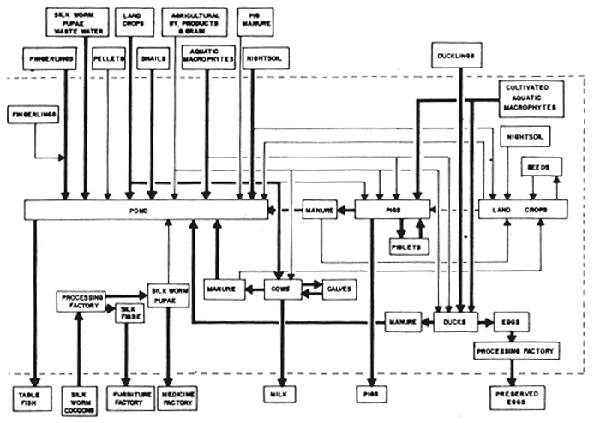
Fig. 2 Wuxi Fish Farm, Li Yuan People's Commune
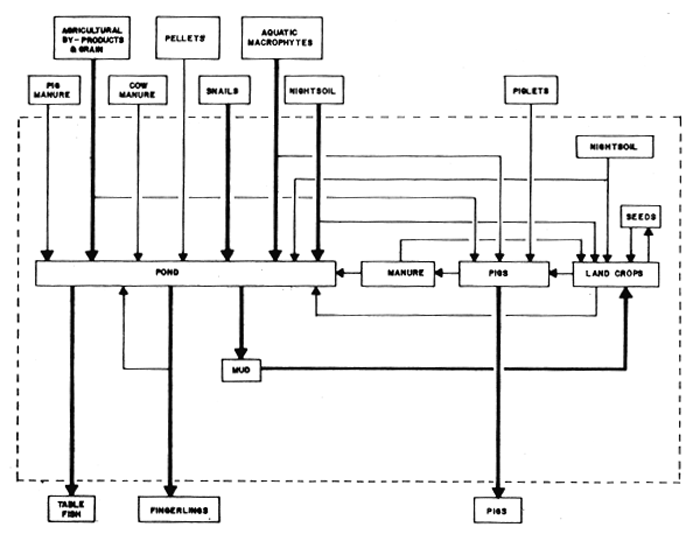
Fig. 3 Fishery Team Number 1, Holei People's Commune
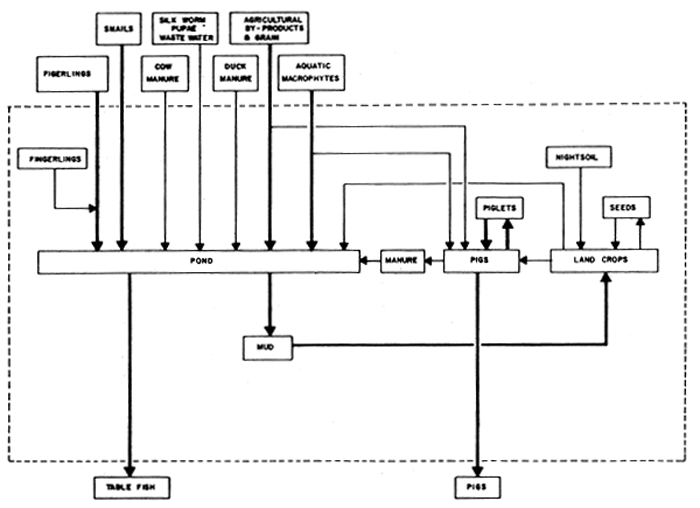

Fig. 4 Wang Chuan People's Commune Fish Farm
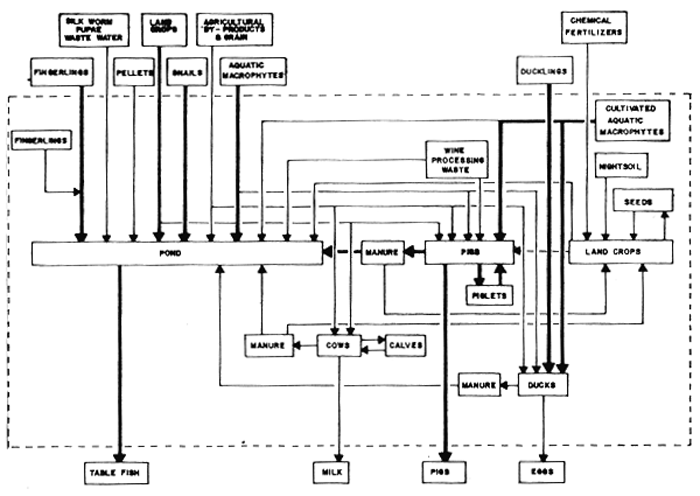
Fig. 5 Xinan Fish Farm, Li Yuan People's Commune
Fig. 6 Zhang Zhuang Production Brigade, Huang Qiao People's Commune
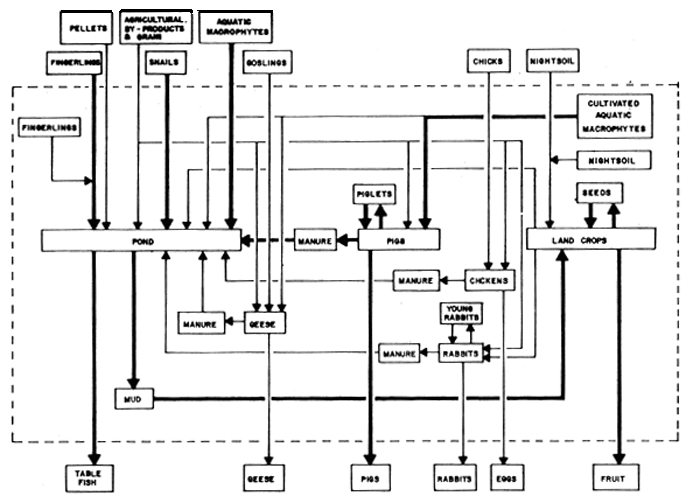
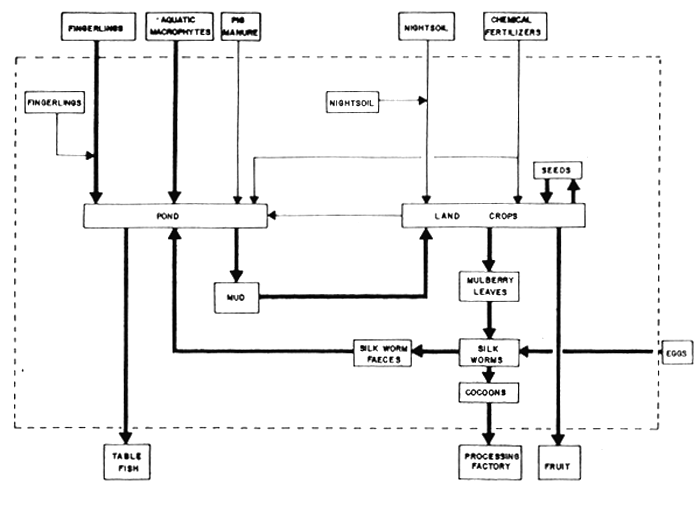
Fig. 7 Jinwen Production Brigade, Tung Shan People's Commune
Fig. 8 Hongjian Fry and Fingerling Farm, Dangxia Peoples' Commune

Fig. 9 Binbu Production Brigade, Shajiao People's Commune
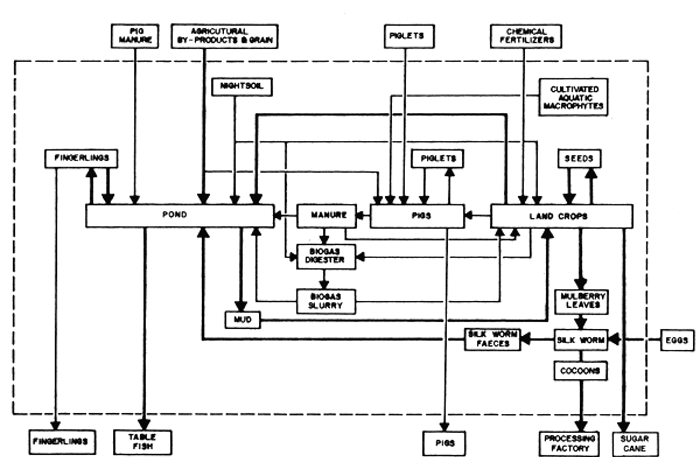
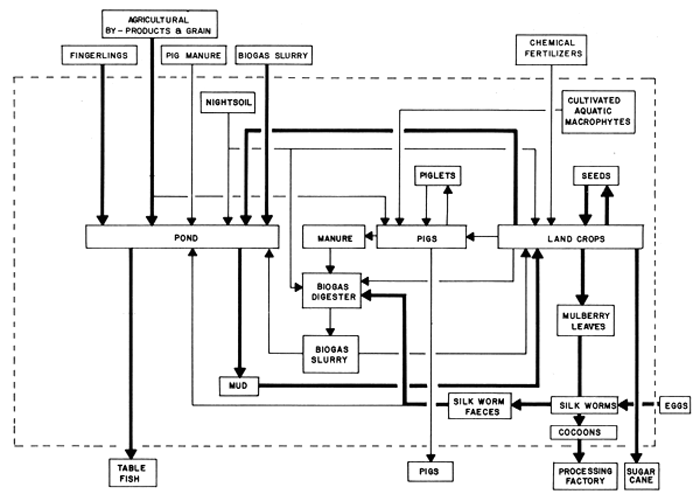
Fig. 10 Xinfu Production Brigade, Le Lin People's Commune
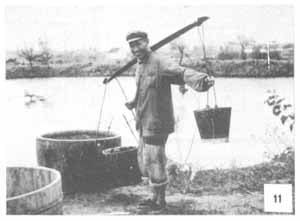 |  |
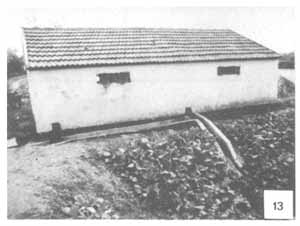 | 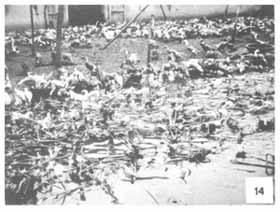 |
 | 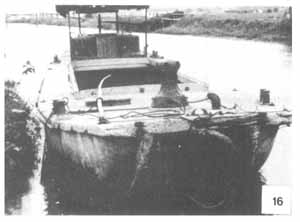 |
Fig. 11 Distribution of pig manure by bucket. Fishery Team No. 1, Holei People's Commune. Fig. 12 Pig sty with manure collecting pit. Holei People's Commune Fish Farm. Fig. 13 Pig sty with manure distribution channel direct to the pond. Fishery Team No. 1, Holei People's Commune. Fig. 14 Ducks eating cultivated water hyacinth. The duck wastewater is pumped to ponds along channels. Holei People's Commune Fish Farm. Fig. 15 Geese eating cultivated water hyacinth. Zhang Zhuang Production Brigade, Huang Qiao People's Commune. Fig. 16 Ferrocement barge for the transportation of organic matter. Xinan Fish Farm, Li Yuan People's Commune.
 |  |
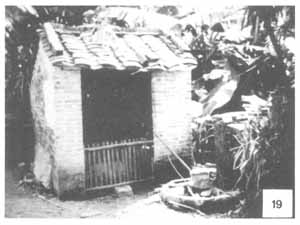 | 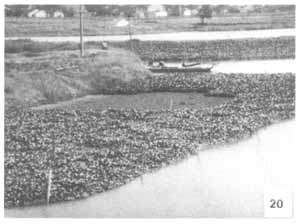 |
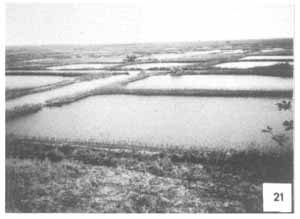 | 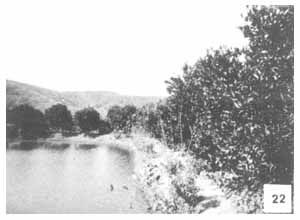 |
Fig. 17 Pumping silk worm pupae wastewater to the pond. Fishery Team No. 1, Holei People's Commune. Fig. 18 Communal pig sty and biogas digester. Xinfu Production Brigade, Le Liu People's Commune. Fig. 19 Family pig sty and biogas digester. Xinfu Production Brigade, Le Liu People's Commune. Fig. 20 Cultivation of water hyacinth and water lettuce. Xinan Fish Farm, Le Liu People's Commune. Fig. 21 Pond dikes covered with mulberry bushes. Tung Shan People's Commune. Fig. 22 Orange trees, mulberry bushes, and vegetables, on a pond dike. Jinwen Production Brigade, Tung Shan People's Commune.
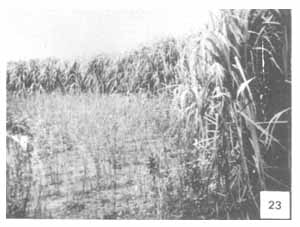 | 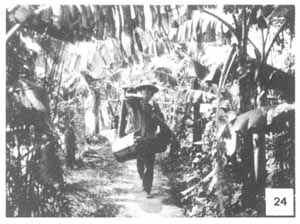 |
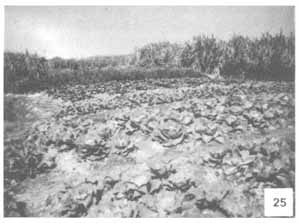 | 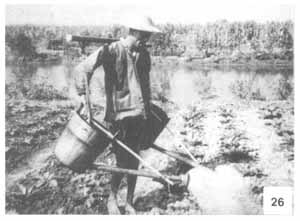 |
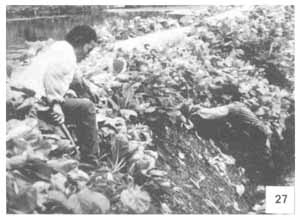 |  |
Fig. 23 Mulberry bushes and suger cane on a pond dike. Hongjian Fry and Fingerling Farm, Dangxia People's Commune. Fig. 24 Bananas on a pond dike. Bindu Production Brigade, Shajiao People's Commune. Fig. 25 Wide pond dikes for the cultivation of vegetables and sugar cane. Bindu Production Brigade, Shajiao People's Commune. Fig. 26 Watering of vegetables on a pond dike. Binbu Production Brigade, Shajiao People's Commune. Fig. 27 Steep and narrow pond dikes for the cultivation of vegetables. Fishery Team No. 1, Holei People's Commune. Fig. 28 Herb (family Borraginaceae) and perennial rye grass cultivated on a pond dike. Fishery Team No. 1, Holei People's Commune.
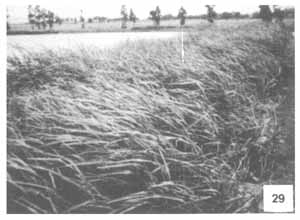 | 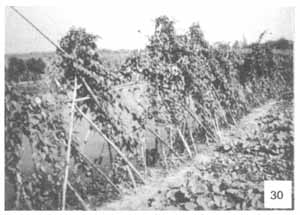 |
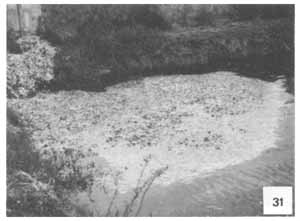 | 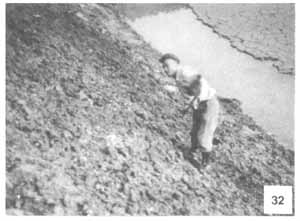 |
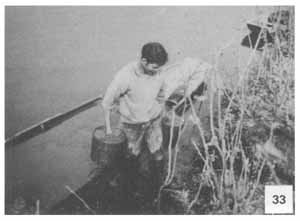 | 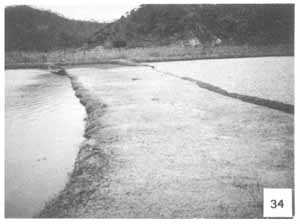 |
Fig. 29 Elephant grass cultivated on a pond dike. Hongjian Fry and Fingerling Farm, Dangxia People's Commune. Fig. 30 Climbing plant cultivated on trellis on pond dike. Binbu Production Brigade, Shajiao People's Commune. Fig. 31 Vegetables added to ponds as green fodder. Xinan Fish Farm, Li Yuan People's Commune. Fig. 32 Removal of pond mud in a drained pond. Wuxi Fish Farm, Li Yuan People's Commune. Fig. 33 Removal of pond mud in a pond containing water for fertilization of mulberry bushes. Le Liu People's Commune. Fig. 34 Wide pond dike covered by pond mud. Fish Farm near Hongjian Fry and Fingerling Farm, Dangxia People's Commune.
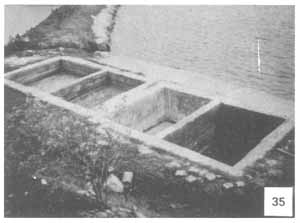 | 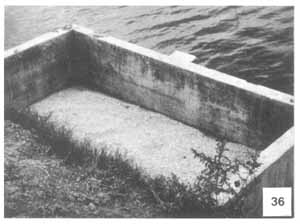 |
 | 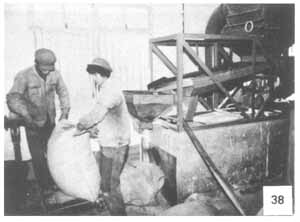 |
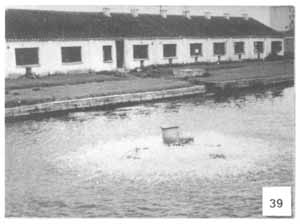 |  |
Fig. 35 A series of concrete storage bins for various agricultural by-products and grain on a pond dike. Hongjian Fry and Fingerling Farm, Dangxia People's Commune. Fig. 36 A concrete storage bin for grain at the pond margin. Xinan Fish Farm, Le Liu People's Commune. Fig. 37 Rice straw added to a pond at the end of the growing season when green fodder is scarce. Hongjian Fry and Fingerling Farm, Dangxia People's Farm. Fig. 38 The manufacture of pellets for fish feed, Wuxi City Fishery Pellet Processing Factory. Fig. 39 Pond aerator. Fishery Team No. 1, Holei People's Commune. Fig. 40 Fish harvest. Bindu Production Brigade, Shajiao People's Commune.
The format is based on:
The information obtained during the field visits to the ten fish farms listed in section 3.2.
The experience of the Wuxi Centre personnel in integrated fish farming in China.
Information obtained from the literature on integrated fish farming systems.
The Consultant's observations on integrated fish farming systems in Thailand in particular, but also in India, Indonesia, Malaysia, Philippines, Singapore, and Taiwan, Province of China.
The detailed format presented below is intended to be comprehensive; it has been designed to contain provisions for the collection of the various kinds of data required for an assessment of integrated fish farming systems throughout Asia as a whole. It is not suitable for field use in its present form, but should be used as the basis for the development of a much reduced format suitable for data collection in a given country, or region of a country.
Detailed Format
| Country: | |
| Province or State: | |
| District or Country: | |
| Village or Commune: | |
| Name of Farm: | |
| Name of Interviewer: | |
| Date of interview: |
1. Climatic Profile
Climatic type
Latitude & Longitude
Altitude
| Month | (4) Air Temperature | (5) Rain fall | (6) Solar irradiance | ||||||
| Minimum | Mean | Maximum | Minimum | Mean | Maximum | Minimum | Mean | Maximum | |
| Jan | |||||||||
| Feb | |||||||||
| Mar | |||||||||
| Apr | |||||||||
| May | |||||||||
| Jun | |||||||||
| Jul | |||||||||
| Aug | |||||||||
| Sep | |||||||||
| Oct | |||||||||
| Nov | |||||||||
| Dec | |||||||||
| Mean | |||||||||
2. Type of Farm and Land Tenure
Privately owned and managed:
Cost of land
Year of land purchase
Present value of land
Privately managed but rented land:
Cost of rent
Illegal occupancy of state or public land
State owned:
Commune Farm
Production Brigade Number of Brigades
Production Team Number of Teams
State Farm
Other
3. Type of integrated farm
Livestock cum fish
Crop cum fish:
Crops grown on dike
Crops grown on separate plot of land
Crops grown in fish pond
Fish grown in crop irrigation system
4. Farm area (m2)
Total farm area related to integrated fish farming
Water area
Pond
Cage
Pen
Other
Pond dike area
Livestock raising area:
| Pond dike | Over or on pond surface | Separate plot of land | |
| (a) Pig | |||
| (b) Cow | |||
| (c) Duck | |||
| (d) Chicken | |||
| (e) Others |
Crop raising area:
| Pond dike | Over or on pond surface | Separate plot of land | |
| (a) Sudan grass | |||
| (b) English rye grass | |||
| (c) Vegetables | |||
| (d) Mulberry | |||
| (e) Fruit trees | |||
| (f) Sugar cane | |||
| (g) Others |
Aquatic macrophyte raising area
| Pond | Canal enclosure | Lake enclosure | |
| (a) Water hyacinth | |||
| (b) Water lettuce | |||
| (c) Alternanthera | |||
| (d) Azolla | |||
| (e) Lemna | |||
| (f) Spirodela | |||
| (g) Wolffia | |||
| (f) Others |
Other land belong to farm
5. Fish pond area allocation (m2)
Brood stock ponds
Nursery ponds
Rearing or grow-out ponds
6. Farm History
Year established
Years for which no records exist
Years for which incomplete records exist
Years for which detailed records exist
7. Farm Water Source
Rain
Spring
Groundwater
River
Canal
Lake
Irrigation system
8. Regularity of water source
Adequate year round
Shortages:
Months when water supply inadequate
Are there water shortages every year
9. Source of fingerlings for 1 calendar year
Off the farm
| Fish species | Total number | Individual weight | Unit cost |
Bred on the farm
| Fish species | Total number | Individual weight | Number used on farm | Number sold | Unit market price |
10. Profile of fish farm manager
Age
Sex
Religion
Education attainment
Is manager also owner:
Yes or no
If no, relationship to owner
Other occupation of manager, if any
Number of years experience in fish farming
Number of years work in this farm
Source of knowledge of fish farming
Is fish farming the main source of income:
Yes or no
If no, what is the major source of income
List any subsidiary or sideline occupations connected with fish culture
11. Farm labour profile
Private farm:
Number of family workers on farm:
Full time
Part time
Number of hired workers on farm:
Full time
Part time
State farm:
Number of workers who live on farm:
Full time
Part time
Number of workers who live off the farm:
Full time
Part time